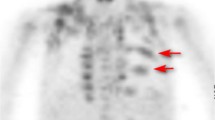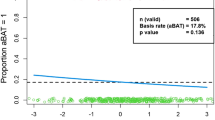Abstract
Introduction
Brown fat uptake of 2-deoxy-2-[F-18]fluoro-d-glucose (FDG) on a positron emission tomography (PET) scan may limit the ability to assess for cancer. Previously, Garcia et al. demonstrated in ten patients a significant decrease in brown fat uptake of 2-deoxy-2-[F-18]fluoro-d-glucose (FDG) after controlling the patient's environmental temperature.
Objective
The objective of the current study is to validate the effectiveness of controlled environmental temperature (CET) to reduce physiologic brown fat (BF) FDG uptake on a PET scan in a larger series.
Method
A retrospective review was performed from January 2002 to October 2007 of patients who had (1) a pattern of FDG uptake on PET scan consistent with BF, (2) no evidence of cancer by computed tomography in the regions of interest noted below, (3) repeat scan with CET within 4 months of the 1st PET scan, and (4) no use of drugs reported to reduce BF FDG uptake (e.g., benzodiazepine, beta-blockers, reserpine) unless they were used identically prior to and during both studies. The FDG-PET and controlled environmental temperature-positron emission tomography (CET-PET) scans were performed as per protocol. The non-CET and CET-PET images were blinded/randomized, and three physicians assessed three regions (right neck, left neck, and paraspinal area) semiquantitatively using the following scale: “0” (background [bkgd]), 1 + (> bkgd < liver), 2 + (equal to liver), 3 + (> liver). Standard uptake value (SUV) data was recorded. Results were analyzed using a two-tailed t test.
Results
Of 8,640 FDG-PET scans performed, 30 patients (four male, 26 female) met the above criteria. The median age was 36 years (range, 12–60 years). The mean (± 1 standard deviation) of differences in the scores between the two studies for right neck, left neck, and paraspinal regions, respectively, were for reader 1:(2.1 ± 1.37), (1.95 ± 1.43), and (1.85 ± 1.26); reader 2 (2.3 ± 1.40), (1.70 ± 1.13), and (1.77 ± 1.13); reader 3 (2.17 ± 1.17), (2.20 ± 1.18), and (0.50 ± 1.30); for maximum SUV score (3.4 ± 2.9), (3.3 ± 2.9), and (1.77 ± 1.13). All p values were <0.001.
Conclusion
In this larger series, CET effectively reduced the false-positive 18FDG uptake in BF on PET scans without the use of drugs.


Similar content being viewed by others
References
Cohade C, Osman M, Pannu H, Wahl R (2003) Uptake in supraclavicular area fat (“USA-Fat”): description on 18F-FDG-PET/CT. J Nucl Med 44:170–176
Yeung H, Grewal R, Gonen M, Schoder H, Larson S (2003) Patterns of 18F-FDG uptake in adipose tissue and muscle: a potential source of false positives for PET. J Nucl Med 44:1789–1796
Hany TF, Gharehpapagh E, Kamel EM, Buck A, Himms-Hagen J, von Schulthess GK (2002) Brown adipose tissue: a factor to consider in symmetrical tracer uptake in the neck and upper chest region. Eur J Nucl Med Mol Imaging 29:1393–1398
Gordon B, Flanagan F, Dehdashti F (1997) Whole-body positron emission tomography: normal variations, pitfalls, and technical considerations. AJR 169:1675–1680
Truong MT, Erasmus JJ, Munden RF, Marom EM, Sabloff BS, Gladish GW, Podoloff DA, Macapinlac HA (2004) Focal FDG uptake in mediastinal brown fat mimicking malignancy: a potential pitfall resolved on PET/CT. Am J Roentgenol 183:1127–1132
Minotti AJ, Shah K, Keller K (2004) Positron emission tomography/computed tomography fusion imaging in brown adipose tissue. Clin Nucl Med 29:4–11
Barrington S, Maisey M (1996) Skeletal muscle uptake of Fluorine-18-FDG: effect of oral diazepam. J Nucl Med 37:1127–1129
Cohade C, Mourtzikos K, Wahl R (2003) “USA-Fat”: prevalence is related to ambient outdoor temperature—evaluation with 18F-FDG-PET/CT. J Nucl Med 44:1267–1270
Garcia CA, Van Nostrand D, Majd M, Atkins F, Acio E, Sheikh A, Butler C (2004) Benzodiazepine-resistant “brown fat” pattern in positron emission tomography: two case reports of resolution with temperature control. Molecular Imaging & Biology 6:368–372
Tatsumi M, Engles JM, Ishimori T, Nicely O, Cohade C, Wahl RL (2004) Intense 18F-FDG uptake in brown fat can be reduced pharmacologically. J Nucl Med 45:1189–1193
Wolfgang A, Weber MD (2004) Brown adipose tissue and nuclear medicine imaging. J Nucl Med 45:1101–1103
Rousseau C, Bourbouloux E, Campion L et al (2006) Brown fat in breast cancer patients: analysis of serial 18F-FDG-PET/CT scans. Eur J Nucl Med Mol Imaging 33:785–791
Parysow O, Mollerach A, Jager V, Racioppi S et al (2007) Low-dose oral propranolol could reduce brown adipose tissue F-18 FDG uptake in patients undergoing PET scans. Clin Nucl Med 32:351–357
Williams G, Kolodny G (2008) Method for decreasing uptake of 18F-FDG by hypermetabolic brown adipose tissue on PET. AJR 190:1406–1409
Bogsrud TV, Lowe V (2006) Normal variants and pitfalls in whole body PET imaging with 18F-FDG. Appl Radiol 35:16–30
Garcia C, Van Nostrand D, Atkins F, Acio E, Butler C, Esposito G, Kulkarni K, Majd M (2006) Reduction of brown fat 2-Deoxy-2-[F-18] fluoro-D-glucose uptake by controlling environmental temperature prior to positron emission tomography scan. Mol Imaging Biol 8:24–29
Foster DO, Frydman ML (1978) Nonshivering thermogenesis in the rat. II. Measurements of blood flow with microspheres point to brown adipose tissue as the dominant site of calorigenesis induced by noradrenaline. Can J Physiol Pharmacol 56:110–122
Author information
Authors and Affiliations
Corresponding author
Rights and permissions
About this article
Cite this article
Garcia, C., Bandaru, V., Van Nostrand, D. et al. Effective Reduction of Brown Fat FDG Uptake by Controlling Environmental Temperature Prior to PET Scan: an Expanded Case Series. Mol Imaging Biol 12, 652–656 (2010). https://doi.org/10.1007/s11307-010-0298-9
Published:
Issue Date:
DOI: https://doi.org/10.1007/s11307-010-0298-9




